-
Archives
- November 2017
- November 2016
- October 2016
- April 2016
- March 2016
- November 2015
- February 2015
- July 2014
- June 2014
- October 2013
- January 2013
- October 2012
- July 2012
- April 2012
- March 2012
- February 2012
- January 2012
- December 2011
- November 2011
- October 2011
- September 2011
- August 2011
- July 2011
- March 2011
- February 2011
- January 2011
- November 2010
- September 2010
- April 2010
- March 2010
- February 2010
- March 2009
- February 2009
- March 2008
- February 2008
- November 2006
- August 2006
- March 2006
- August 2005
- July 2005
-
Meta
Monthly Archives: October 2013
Tibet-Dispatch 3
How to bring you here, to share this experience with me. Ordinarily I have a good story to recount, a funny experience, an odd encounter, that brings to life the otherness of where I am. But what do I do when I’ve been in a different world, one for which there are no GPS points relating to my normal life nor to anything I’ve seen or done before.
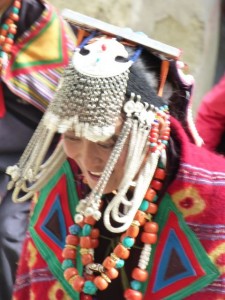
This has been a trip of landscape more so than people, unless you count yaks as people, in which case there’s been a lot of that. The Tibetan Plateau has me awestruck. For days we have been traversing plains of curry and cinnamon velour, stretching for a hundred miles without a bump. At a continuous altitude of 15,500 feet we are high above tree line, yet still, thankfully, below snow line. When I’m out of the car, the sun beats intensely on my skin, but the wind blows strong, with sharp edges that carry a chill.
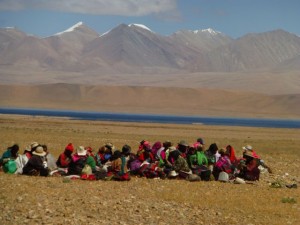
At the edges of these plains the velour carpet thrusts up with an abruptness that defies geologic creation of the volcanic sort. These are crumpled hills, like the earth making a fist that is all bare knuckles. They rise another 3,000 feet or more in colors of clove and bittersweet chocolate, some rocky, some softly carpeted in low grasses. The boundary between plain and hill is so startlingly it’s as if they say, “And you thought that was high! Wait till you see this!!” And still those hilltops, which in my beloved Colorado would overtop even the highest peak, taper off below snow line.
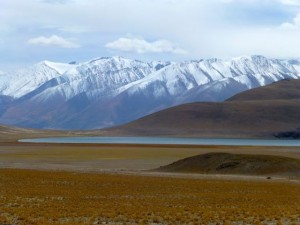
As we jar along on jaggedly rocky tracks, the road chances to swoop in a mile-long curve, and then mountains appear. We’ve driven on the north side of some of the most storied peaks in Himalayan mountaineering lore. As we left holy Lake Manasarovar and Mt. Kailash, the monumental summit of Nanda Devi stood head and shoulders above all nearby peaks, her white cliffs blushing pink in the first rays of a late dawn.
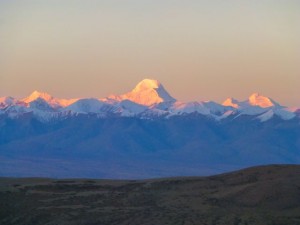
Day after day in the high reaches of the Tibetan Plateau, the snow line sinks. When I emerge from the guest house where we’ve slept the night (more on that in a minute) the confectioner sugar that sprinkled the higher peaks has changed to a thick whipped cream covering, and the white sprinkling is now lower on the mountain flanks.
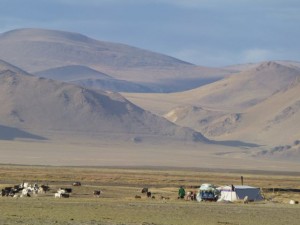
This plateau we are traversing is the highest in the world and arid to the point of receiving less than a few inches rain a year. Yet it is lake country in the finest sense, with both fresh and salt water lakes created when two continental plates smashed together, forming the Himalayan range and creating basins that trap snowmelt and rivers into lakes of a passionate turquoise and aqua color. Four of the ten highest lakes in the world are in Tibet, at altitudes that puts Lake Titicaca (12, 464 feet) to shame.
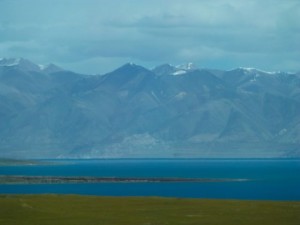
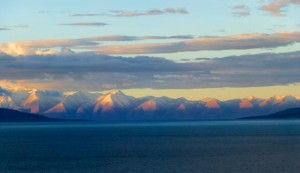
During the day we progress slowly, averaging 35mph only at the best of times. I had expected to pass through small villages, places to which herders of those aforementioned yaks would retreat during the depths of winter. But there are none, at least not real ones. Once or twice a day we pass through China-made facsimiles, with a half-mile strip of concrete for a Main Street and solar-powered street lights illuminating the packs of furry black dogs that roam freely.
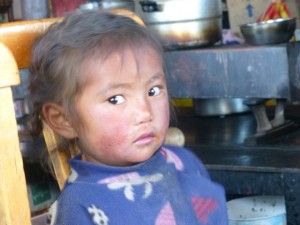
These are sad places, where village women sit on the ground, prayer wheels spinning, and young Tibetan men pass the time shooting pool on outdoor pool tables. In one or two there’s a cemetery of small stone chortens on the outskirts, evidence perhaps that there was once a bonafide Tibetan town here.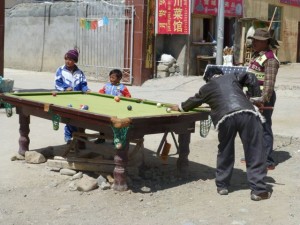
In the evenings, we eat in a local teahouse, sitting on carpeted wood benches around carved and painted low wood tables. A large tin kettle boils on a blackened steel stove in which a dung fire flares and dies. Whatever manure is at hand is used, whether little round goat pellets or chunks of yak droppings. The smoke has its own particular incense, a mix of moldy tobacco and wet cement, and it stings the back of my throat. 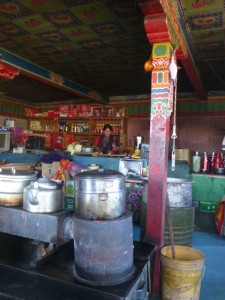 We make a meal of rice with a few plates of vegetables such as cauliflower, cabbage and bok choy. Sometimes there are curled snippets of yak meat in the dish. I scour each platter for those deadly red peppers and use my chopsticks to pick them out in advance. Our food is undoubtedly richer than what locals eat, but is lean nonetheless.
We make a meal of rice with a few plates of vegetables such as cauliflower, cabbage and bok choy. Sometimes there are curled snippets of yak meat in the dish. I scour each platter for those deadly red peppers and use my chopsticks to pick them out in advance. Our food is undoubtedly richer than what locals eat, but is lean nonetheless.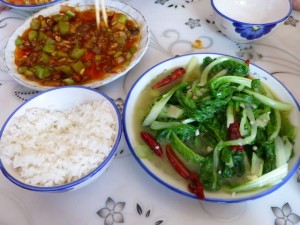
Dinner is our only meal, though I am grateful for the hardboiled egg I am able to get each morning. I have tried the thin rice gruel Tibetans eat in the morning, but it did nothing for me. Lunch usually is scrounged from our supplies in the back of the car: chocolate chip cookies, a big hunk of gouda donated to the expedition by Sabrina before she had to return to Hong Kong, salty crackers, chocolate bars And spam. Yes! Spam!!! This was Paul’s idea, who has a charming if incomprehensible attachment to the stuff from his childhood years. I declined spam the first week, but then hunger overcame my better judgment. The day I put a cracker with spam on it in my mouth was the day I tossed all culinary principles to the wind. All I could say as I chewed the bland, fatty stuff was, “Wish I had some cornichons.”
On the far reaches of the plateau, nestled beneath the towering hills, will be a solitary white tent, with a thin curl of smoke rising from the peak, the seasonal home of a nomad and his family, who tend not only yak, but herds of small white sheep and cashmere goats. 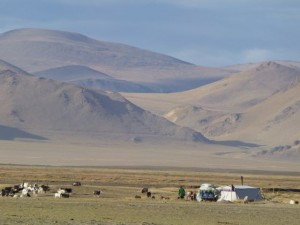 Now and then we cross paths with a man on an underpowered motorcycle handlebars decorated with green tassels, garlands of plastic flowers and lengths of prayer flags, seat covered in layers of carpet, wares piled high behind. It creeps along at barely faster than walking pace. The man wears his black hair in a long braid wound around his head with a scarlet cord. He’s in a thick coat, sometimes lined with fur, knee length and cinched at the waist. His skin is darkly tanned, cheeks ruddy with cold and wind. We nod at each other as he passes, and raise a hand in a short greeting.
Now and then we cross paths with a man on an underpowered motorcycle handlebars decorated with green tassels, garlands of plastic flowers and lengths of prayer flags, seat covered in layers of carpet, wares piled high behind. It creeps along at barely faster than walking pace. The man wears his black hair in a long braid wound around his head with a scarlet cord. He’s in a thick coat, sometimes lined with fur, knee length and cinched at the waist. His skin is darkly tanned, cheeks ruddy with cold and wind. We nod at each other as he passes, and raise a hand in a short greeting.

Despite the harsh climate we have seen wildlife : herds of wild donkeys, caramel colored with ivory legs; black-necked cranes which revered by Buddhists and breed on the Tibetan Plateau; Tibetan antelope and water deer, along with marmots (not quite like ours)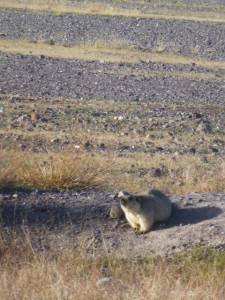
 and the same enormous lammergeier buzzards that we saw in Ethiopia. The lakes themselves, though, are strangely silent and empty. There’s no bird life around, which makes me think there no bugs on the shore nor fish in these high waters. But how could that be?
and the same enormous lammergeier buzzards that we saw in Ethiopia. The lakes themselves, though, are strangely silent and empty. There’s no bird life around, which makes me think there no bugs on the shore nor fish in these high waters. But how could that be?
We did pass through one village whose narrow streets, personalized houses and sense of age struck us all as the first and only authentically real Tibetan village on this trip. 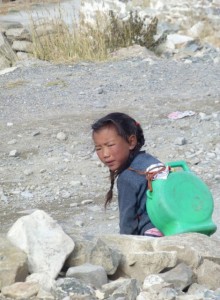 This was the village of Ombu, where one of the last remaining Tibetan monasteries also still functions. We’ve been in other monasteries on this trip, but all of them were simply shells, with a handful of monks retained to let in visitors, as compared to the sometimes thousands that used to reside in them prior to 1959. In Ombu the sense of permanence was still there, and I know I breathed a sigh of relief to be in a place that was legitimately alive with its own sense of history and purpose, rather than being an artificial implant.
This was the village of Ombu, where one of the last remaining Tibetan monasteries also still functions. We’ve been in other monasteries on this trip, but all of them were simply shells, with a handful of monks retained to let in visitors, as compared to the sometimes thousands that used to reside in them prior to 1959. In Ombu the sense of permanence was still there, and I know I breathed a sigh of relief to be in a place that was legitimately alive with its own sense of history and purpose, rather than being an artificial implant.
Which brings me to the most lasting impression from our traverse of the plateau: a sense of a people and culture vanishing before my eyes. Of standing on the edge of what was and seeing it fade into history, a ghost of what used to be. Of derelict towns, built in a Disneyland caricature of Tibetan architecture, populated by Chinese shopkeepers, with Tibetan nomads wandering the dirty streets, devoid of livestock. OK, I know I saw only a fraction of the country, and I know my impressions are based on a superficial view and not in-depths analysis. Still, I couldn’t help feeling as we drove along that all those garlands of prayer flags whipping in the wind were waving good-bye.
Posted in Dispatches, Tibet
Leave a comment
Tibet-Dispatch 2
The farther west we go in Tibet, the more arid and high the country becomes. We are now routinely at over 4500 meters. The air is thin and dry; I breathe it in great gulps, and still don’t quite feel that I’ve gotten a satisfying deep breath. The sky is a blue so bright I squint behind the polarized lenses of my RayBans.
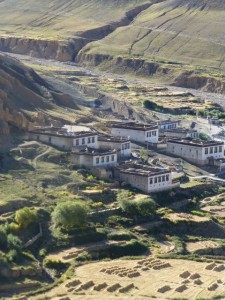
In the folds of rolling ochre hills, shepherds pasture their yak herds, moving slowly lower as the snows of winter encroach. The grass is as sparse as day-old stubble, yet the yaks look robust, more so than the children of the shepherds, who are thin and ragged, a six-year-old looking like a four-year-old. Small sheep and goats also populate these hills, which in a state like Colorado would overtop even the highest fourteener. Here, the snow covered peaks only begin around twenty thousand feet.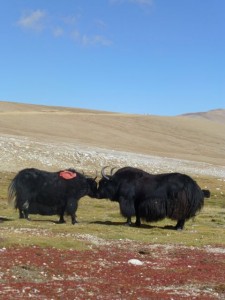
The yaks, mostly black though there’s an occasional beige or cream-colored one, sport long wooly skirts. They don’t hesitate to issue a grumbling cough and flick their long bushy tails at us when we come too close.
We’ve gone from the golden stubble of barley fields being harvested on the plains below Everest, to the mighty west face of Everest itself, rising clear and grand from Rongbuk glacier into the rays of a brilliant white full moon. 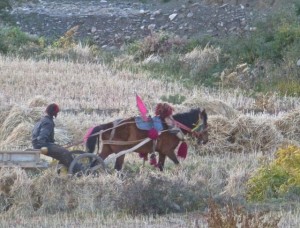
A rugged drive over roads carpeted with jagged rocks took us through the above-mentioned alpage, then along a ribbon of highway empty of cars except us and the occasional other tourist Land Cruisers, all of them filled with Chinese tourists.
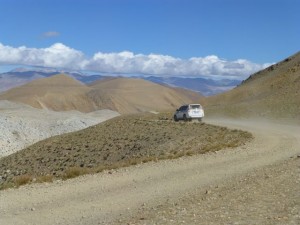
This year the Chinese government issued only 10% of Tibet visas to westerners, so we feel especially lucky to be here. In fact, the stated goal of the government is to dilute the native Tibetan population to 50% of inhabitants of the Tibet Autonomous Region, by 2018. Chinese are encouraged to travel here in hopes they will return permanently, open businesses (it’s tax-free for them), and partake in achieving that goal.
The central Tibetan towns are dusty and bedraggled, crumbling sidewalks lined with 10×12 stalls that serve as restaurants or mini-marts selling toothpaste, cookies and sweet drinks. One town, Saga, was in the midst of city-wide infrastructure ‘improvement.’ The rich steam from packets of Nescafe dumped into hot water could not displace the odor of raw sewage from the open trench that ran in front. Happiness comes when one of us spies a box of Snickers for sale, which in my experience is the best treat one can have on these trips, where everything is so foreign in smell, taste and sound.
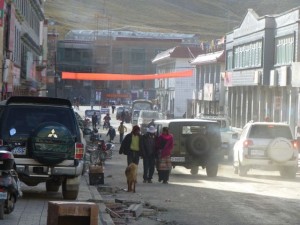
Our breakfasts are sparse, featuring a hardboiled egg if we’re lucky, and perhaps a chapati-like flatbread favored by Tibetans. I haven’t yet screwed up my courage to sample the typical Tibetan breakfast, which is made of tsampa (barley flour) mixed with yak butter. But I will, I swear…..

One glorious afternoon we hiked up to a viewpoint below Mt. Kailash, the sacred mountain of Buddhists which is also the source of the headwaters of the Indus, the Sutlej and the Brahmaputra rivers. Prayer flags flapped in the strong wind and a faraway monastery pulled a disappearing act behind the foothills as we walked upward to a flag-draped promontory at 5,075 meters.
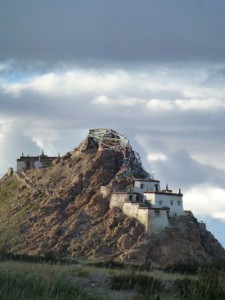
Below, pilgrims and devotees followed the broad path around Kailash’s circumference, some prostrating themselves at designated prayer stations, observed by thick-coated black village dogs, descendants perhaps of the huge Tibetan mastiff.
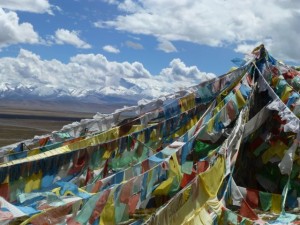
We have just reached the western-most point in our journey, the town of Toling/Zanda (most towns have both a Chinese and a Tibetan name). It is lovely here, as we are back down below tree level, with poplars turning yellow and the Sutlej river running pearl blue toward India. A twisting road through wrinkled cliffs of beige sandstone took us up to snow level before depositing us in this fertile valley.
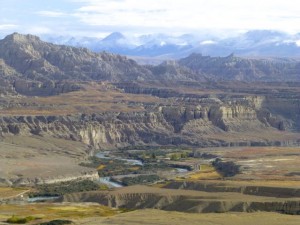
The town itself is cleaner and quieter than any other we’ve been through, making it actually pleasant to stroll down the street. 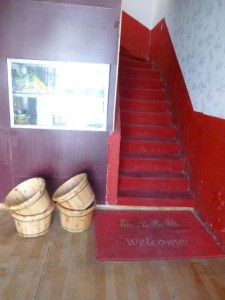 It is in that way that I discovered the local foot massage parlor, up a red-carpeted flight of stairs, in a bright clean room with windows shielded by yellow flowered curtains. There I spent a blissful hour and a half with my feet soaking in an oak tub filled with hot water and an herbaceous concoction of Chinese herbs, my back and limbs being pounded, pulled and jabbed like the lump of dough I feel I’ve become, followed eventually by an excruciating excavation of every knot and hard spot on the soles of my feet. Heaven!
It is in that way that I discovered the local foot massage parlor, up a red-carpeted flight of stairs, in a bright clean room with windows shielded by yellow flowered curtains. There I spent a blissful hour and a half with my feet soaking in an oak tub filled with hot water and an herbaceous concoction of Chinese herbs, my back and limbs being pounded, pulled and jabbed like the lump of dough I feel I’ve become, followed eventually by an excruciating excavation of every knot and hard spot on the soles of my feet. Heaven!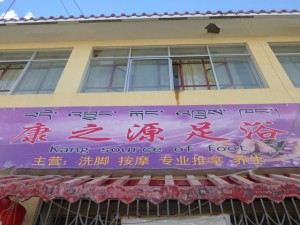
Posted in Dispatches, Tibet
Leave a comment
Tibet-Dispatch 1
It was with a mix of dread and anticipation that I stepped off our All Nippon Airways flight into the heat of Beijing three days ago. Last time I was here we were five days away from starting the Peking to Paris rally. This time is different, Beijing is but prelude to the fugue of a very special journey. We are off to the wilds of Tibet heading by car into the most remote western and north central regions of the Tibetan Plateau, seeking to get as close as we can to the heart of this special country before it is stilled forever by encroaching China-ization.

On our 45-day Istanbul Calcutta drive in 2011 we spent five days motoring through Tibet. As we went through border formalities departing China and entering Nepal, I mostly was relieved to be done with the searing altitude headache that had wrapped itself around my forehead days earlier and been squeezing my brain like an overly-tightened cinch ever since. I was never quite sure whether that headache, and the persistent tingling that had invaded my fingertips, gums and the soles of my feet, were the result of altitude, or the drugs I was taking to help me adjust to the altitude. Mostly I was joyous to be leaving the strict constraints of driving in China, where overhead cameras enforce a 25mph speed limit over stretches of pavement as smooth as a baby’s bottom and as empty as a new diaper! Never had the potholed, cacophonous chaos of Nepalese and Indian roads been so freeing.
To my surprise given how short a time we were in the region, Tibet has stayed in my consciousness, and so it was with genuine pleasure that I informed our friend Paul that we would accept an invitation to join the trip to Tibet he was organizing if he would only issue one. Paul, in a fit of politeness, or perhaps having forgotten just how grumpy a traveller I can be at times, did just that.
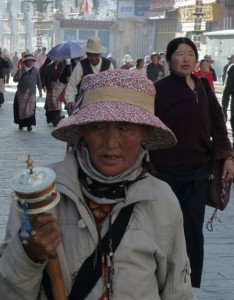
And so we arrived in Beijing after the usual cripplingly long flight that left me shaped like an airplane seat and despairing of ever completing any Pilates exercises again. After the initial sweating in panicky deja vu which I mention above, I have felt fully at peace. For one, I am a seasoned road warrior now. Though I haven’t totaled the number of miles we’ve driven since 2007, it must be pushing 50-60,000. There isn’t a whole lot about long days of driving that I haven’t experienced. Or, to put this another way, I’m more competent at self-soothing, more skilled at avoiding mind-dramas about awful things that may happen. At least not until it seems possible they will. Happen.
There’s another, even better reason for my present state of happiness. I’ve had nothing to do with the organization of this journey. That honor goes to Paul, whom we met on the long drive from Istanbul to Calcutta two years ago. Paul is a master at creating interesting road adventures. You can read more about our anticipated route here. Other than packing my own suitcases, in case they asked me about that at the airport, I’ve been delighted to leave everything in his capable hands.
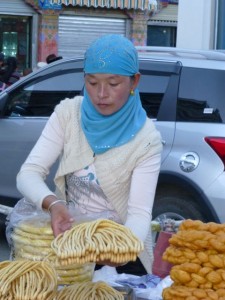
We are sharing this journey with a handful of other adventurers. There’s Martin, who walks so fast he probably could have beat the plane from Beijing to Lhasa. While I am staggering up a short, gentle incline to a slope-side monastery in the rarefied air of Mt. Kailash he plans to run a 50km route. No doubt he’ll beat us there. Martin’s wife Sabrina, and their daughter Magdalene are on for the drive, too. Also along is David, who is so imbued with all things oceanic that I can only admire his fortitude bearing up for weeks in a land-locked country. We are all already quite compatible travelers.
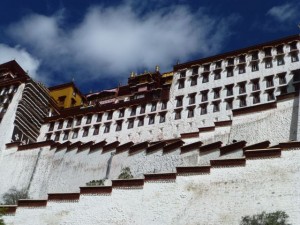
Bernard and I found Lhasa even less Tibetan than two years back. There’s a big ferris wheel and amusement park near the entrance of the city. Garish lights have been installed in the plaza across from Potala Palace where, in the evening, music blared from loudspeakers and Chinese visitors line danced to the tunes, executing restrained hops, shuffles and arm swings to the beat. I joined in one dance, adding my own out of sync gyrations to the mix. It was fun. But somehow it felt unseemly.
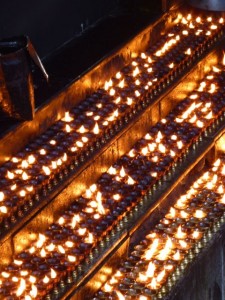
We easily retraced our steps from two years ago to find Jokhang Temple and wander the market streets, dodging pilgrims twirling prayer wheels or prostrating themselves on the cobbles with a chant and a clack of handheld blocks. Eager to start my forays in adventurous eating, we stopped at a stall where a small circle of men stood around one seated with a broad flat grass basket on his lap. Piled on it with slender 2-inch long, rippled beige sticks, which he shook up, down and around. Peering closer I realized they were dried caterpillars. I’ve never had dried caterpillar. Have you?
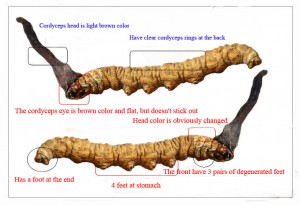
I took a proffered caterpillar, inspected its belly, then gingerly bit its head off. I imagined it would be crunchy on the outside and pleasingly squishy on the inside, like a soft caramel in a crackly chocolate skin. As for taste, that’s what I was here in to find out! The men stared at me, their looks changing from amused to horrified as I thoughtfully chewed the little head. I tried to smile, but didn’t want to insult them by appearing flippant, so changed my expression to contemplative, hoping to show my connoisseurship in all things larva.
I have to say there’s nothing distinguished about dried caterpillar. It tastes just like it looks: pale, wan and dry. The more I chewed the more agitated the vendors became, finally grabbing a calculator and jabbing in some numbers. The number 100 appeared on the screen, then was rapidly changed to 400. They wanted to charge us over $70 for one never-to-be-butterfly. Bernard offered them 10 yuan. This nearly provoked a riot and expressions became threateningly severe. The men moved closer, frowns gathered like rain clouds during the monsoon and were just as black. We finally compromised on $25, I stuck the headless desiccated stub in my pocket and we walked off. Only later did I learn that it wasn’t even a real caterpillar, it was a fungus, prized (naturally) for its medicinal purposes. A hundred grams of the stuff sells for $900.
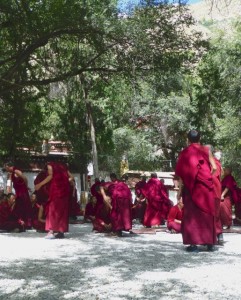
After these two welcome days of acclimatization at 11,450 feet, we start our drive tomorrow. Our first course of business is a return to Rongbuk and Everest base camp. Fingers crossed we’ll be blessed with sparkling clear skies as we were two years ago. I’ll be writing dispatches along the way, but doubt I’ll be able to send anything for the first five days or so. Be prepared for a deluge of photos and news once I get to a place where internet is viable.
Posted in Dispatches, Tibet, Uncategorized
Leave a comment










